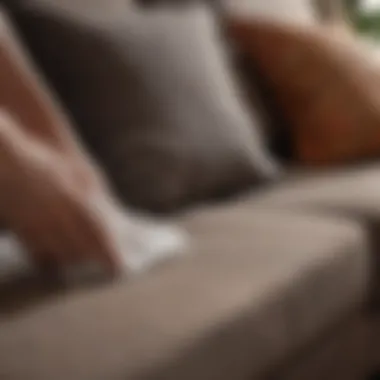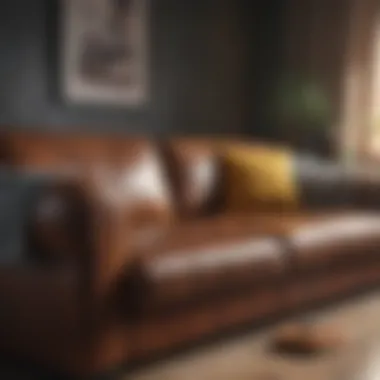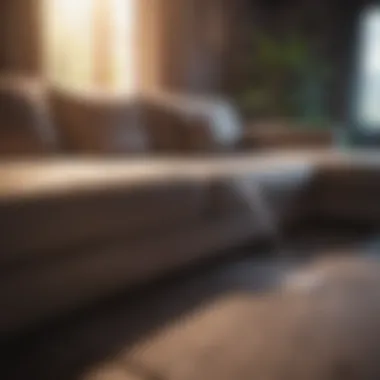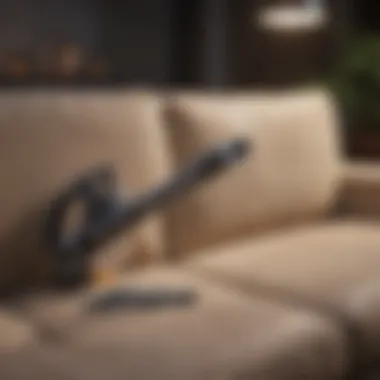How to Disinfect Your Couch: Expert Tips and Techniques


Intro
Disinfecting a couch is more than just removing surface dust or stains. It entails a systematic approach to eliminate germs, allergens, and odors that can accumulate over time. Different upholstery types, from fabric to leather, require distinct methods to ensure effective cleaning without compromising integrity. This guide offers practical steps, necessary materials, and insight into eco-friendly cleaning solutions, making it relevant for homeowners, interior design enthusiasts, and anyone keen on maintaining a hygienic living space.
Design Inspirations
While a couch serves a functional purpose, its aesthetic contribution cannot be overlooked. Designers today focus on creating pieces that balance style and practicality. By paying attention to design inspirations, homeowners can select couches that not only fit their needs but also elevate their interior spaces.
Trending Styles
In the realm of couch design, trends fluctuate. Currently, minimalist designs are remarkably popular. They emphasize clean lines and neutral tones, making it easier to match with various decor. On the other hand, vintage styles have regained their allure. These designs often incorporate bold colors and intricate patterns that can serve as statement pieces within a room. Regardless of your chosen style, it is essential to consider how the couch will accommodate your lifestyle and how it integrates into your overall home decor.
Color Palettes
As for colors, the choices vary widely. Neutral shades such as gray and beige are classic and versatile, but don't hesitate to explore deep, vibrant hues like teal or mustard yellow. These colors can create visual focal points. It’s essential to select a color that aligns with your personality while remaining functional enough to hide daily wear and tear.
Maintenance and Upkeep
Regular maintenance not only prolongs the lifespan of your couch but also ensures a cleaner living space. Follow a systematic approach to keep it looking fresh.
Seasonal Maintenance Checklist
- Vacuum Regularly: Use a vacuum suitable for your couch type at least once a week.
- Spot Clean Stains: Address spills immediately with appropriate cleaning products.
- Rotate Cushions: This helps to distribute wear evenly.
- Deep Clean: Schedule a deep cleaning every six months using methods suitable for your upholstery.
Cleaning and Organization Tips
- Use Quality Cleaners: Choose solutions that are safe for your specific fabric type.
- Test Before Use: Always test cleaners on a hidden part of the couch to prevent damage.
- Maintain Airflow: Keep the area around the couch clean to prevent dust accumulation.
"A clean couch can transform a home’s atmosphere, making it feel more inviting and comfortable."
Investing time in these practices ensures your couch looks its best for years to come. Overall, understanding how to effectively maintain and disinfect your couch not only enhances your living environment but also provides peace of mind.
Understanding the Importance of Couch Disinfection
Couch disinfection is not merely a matter of aesthetics; it plays a vital role in maintaining the overall health and hygiene of a living space. Couches often serve as gathering spots for families and guests, making it essential to ensure that these pieces of furniture are free from harmful microorganisms. Regular disinfection can significantly reduce the risks posed by germs and allergens commonly found in upholstery, creating a safer environment for everyone.
Health Risks Associated with Unclean Upholstery
Upholstered furniture can harbor a variety of pathogens, including bacteria and viruses. Unclean couches can lead to health issues such as respiratory problems, allergies, and in some cases, severe infections. According to studies, surfaces that are often ignored during cleaning can accumulate pathogens over time, potentially compromising the health of individuals who use them.
For homeowners with children or pets, the stakes are even higher. Infants and small children, in particular, may spend considerable time on the couch, increasing their exposure to contaminants. The presence of allergens like dust mites, pet dander, or mold can exacerbate allergies or asthma, discomforting many throughout their daily lives. Therefore, regular disinfection can mitigate these health risks and promote a cleaner, safer living space.
The Role of Allergens and Bacteria
Allergens and bacteria thrive in many household environments, with couches being a prime location due to their fabric composition. Dust mites are microscopic creatures that feed on dead skin cells and can conceal themselves within upholstery fibers. Their presence may trigger allergic reactions, leading to sneezing, coughing, and skin irritations.
In addition, various types of bacteria can be found on couches, some of which can lead to illness. Pathogens such as E. coli or Salmonella can transfer from the human body or food products to upholstery, posing a risk, particularly if they're not addressed promptly. When people sit or lay down, they unknowingly transfer bacteria onto the couch, which can multiply if the couch is not cleaned regularly.
Thus, understanding the key role of couch disinfection in managing allergens and bacteria is critical for ensuring the overall cleanliness and safety of your home. Proper disinfection not only enhances the aesthetic appeal of your couch but also lies at the heart of a healthy living environment.
Assessing Your Couch Material
Understanding the type of material your couch is made from is crucial when it comes to disinfecting it effectively. Each upholstery type has distinct characteristics that influence how it should be cleaned. Using the wrong cleaning product or method can damage the material, leading to issues like discoloration or texture change. Moreover, some materials are more susceptible to absorbing odors and allergens than others, which makes it even more important to choose the right approach.
Fabric Couches
Fabric couches come in various materials, including cotton, polyester, and blends. When disinfecting fabric, it is essential to consider whether the fabric is delicate or durable. For example, cotton may tolerate water-based cleaners, while some synthetic blends may require gentler solutions.


Before applying any cleaning solution, check the manufacturer’s label for cleaning instructions. A simple vacuuming can help remove dust and hair before the disinfection process begins. After vacuuming, spot-test a small area with your chosen disinfectant to ensure there is no adverse reaction. This approach protects the fabric from potential damage.
Leather Couches
Leather couches require a different cleaning method due to their unique composition. While leather is resilient, it is also vulnerable to drying out and cracking if exposed to harsh chemicals or excessive moisture. A gentle cleaner specifically designed for leather is recommended.
Start by dusting off any surface particles with a microfiber cloth. Use a leather cleaner and apply it according to the instructions. After cleaning, use a leather conditioner to maintain suppleness and prevent future damage. This process helps ensure that the leather remains both hygienic and visually appealing.
Microfiber Couches
Microfiber is known for its stain resistance and durability. However, it is essential to use care when disinfecting these couches as well. Microfiber typically allows for water-based cleaning solutions. A mixture of mild soap and water can often provide an effective clean.
To disinfect, work the cleaning solution into the fabric with a soft brush in circular motions to lift dirt and germs. Rinse the brush often to avoid spreading dirt. After the couch has been cleaned, air drying is best, as excessive heat can cause the fabric to shrink or warp.
Synthetic Upholstery
Couches made of synthetic upholstery tend to be quite practical. These materials, such as nylon or polyester, are generally more resistant to stains and easier to clean. When disinfecting synthetic upholstery, using a solution that combines soap and warm water often suffices.
Before applying any cleaning product, ensure the upholstery is compatible with the chosen solution. Testing in a small area first is advisable. After disinfecting, allow the couch to air dry. Synthetic fabrics often dry quickly, but avoid direct sunlight which could fade the colors.
By understanding the specific materials your couch is made from, you can choose the right cleaning methods. This knowledge protects the couch and ensures a clean and healthy living environment.
Gathering Necessary Supplies
Collecting the right supplies is a crucial first step in disinfecting a couch. The effectiveness and safety of the process largely depend on proper preparation. Having your materials ready not only streamlines the disinfection but also ensures that you can tackle any issues that may arise effectively.
Cleaning Solutions
The choice of cleaning solutions can greatly impact the disinfection process. Various solutions are available that cater to different upholstery types. For instance, a general purpose solution containing isopropyl alcohol can effectively reduce germs on many fabrics. However, it is vital to ensure that these solutions are safe for your specific couch material.
Some people prefer eco-friendly options, like vinegar and baking soda, which are less harsh on the environment. Additionally, products that claim to be antimicrobial should be considered carefully. Ensure they meet safety standards and are designed for home use. Having a selection of solutions on hand can make it easier to adjust your cleaning strategy as needed.
Equipment and Tools
Proper equipment is another important aspect of couch disinfection. Basic items may include:
- Vacuum cleaner: Essential for removing loose debris and dust.
- Soft cloths: Microfiber or soft cotton cloths work best to avoid damaging your upholstery.
- Spray bottles: For even application of cleaning solutions.
- Brushes: Soft-bristled brushes can help in treating stains without harming the couch fabric.
Each tool plays a role in ensuring that you can execute the cleaning process efficiently and thoroughly. Selecting the right equipment minimizes the risk of damage while enhancing the effectiveness of your efforts.
Protective Gear
Disinfection processes can sometimes involve exposure to chemicals or allergens. Therefore, protecting yourself is just as important as cleaning the couch. Wearing gloves will prevent skin irritation from cleaning solutions. If you are sensitive to dust, wearing a mask is advisable to avoid inhaling particles during vacuuming.
Eye protection is also recommended if working with sprays that may irritate. Follow simple safety practices to keep your health protected. In the end, being well-prepared with the appropriate supplies not only aids in effective cleaning but also ensures that you create a safe environment for yourself and your home.
Preparing for Disinfection
Disinfecting a couch is an essential task that goes beyond mere aesthetics. A clean couch not only enhances the look of your living space but also contributes significantly to the overall health of your home. Preparing for disinfection lays the groundwork for efficient cleaning. When done correctly, it can prevent damage to your furniture and ensure that the disinfection process is thorough and effective. The right preparation methods directly influence how well you can eliminate germs, allergens, and other unwanted substances.
Before you begin, it's necessary to assess the state of your couch and what needs to be cleaned. This ensures you address all potential trouble spots. Taking these preparatory steps will ultimately save time and enhance the effectiveness of the cleaning process.
Emptying the Couch of Items
Clearing the couch of any items is a vital first step. Remove cushions, throws, and any decorative items that might be present. Look under and between the cushions for personal belongings, food crumbs, or other debris. This not only reveals hidden dirt but also provides an opportunity to clean areas that are usually neglected.
This step prevents interference during the actual cleaning process. Leaving objects on or in the couch can hinder access and lead to incomplete cleaning. It is also a form of protective measure for these items against any cleaning agents.
Vacuuming for Loose Particles


Once the couch is empty, vacuuming should be your next step. Use a high-quality vacuum cleaner with appropriate attachments to cover different areas. Pay attention to seams, crevices, and beneath the cushions. Loose particles like dust, hair, and crumbs can harbor allergens and bacteria.
– Benefits of Vacuuming:
- Reduces allergens that may cause respiratory issues.
- Enhances the effectiveness of disinfection solutions by removing larger debris.
- Creates a cleaner canvas for the disinfecting agents to work on.
Not only vacuuming improves cleanliness, but it also prolongs the life of the upholstery. Regular vacuuming prevents the buildup of dirt that can wear down fabric and other materials over time.
"Preparation is key to ensuring a successful disinfection process."
Thus, taking the time to thoroughly empty and vacuum your couch sets the stage for an effective disinfection routine. Missing these steps can lead to an unsatisfactory result, ultimately making your efforts less effective.
Step-by-Step Disinfection Process
Disinfecting your couch is more than just a regular cleaning task. It is an essential process aimed at eliminating germs and allergens that can accumulate over time. A proper disinfection routine protects not only the couch’s integrity but also the health and well-being of those using it. The step-by-step approach allows homeowners to target specific needs based on upholstery type, stains, and odors while ensuring that no crucial detail is overlooked. Following a systematic method guarantees comprehensive cleansing and sanitation.
Applying the Cleaning Solution
The choice of cleaning solution is critical in the disinfection process. Each upholstery type has unique requirements, and using the wrong solution can lead to damage or ineffective cleaning. Begin by testing any cleaning product on a hidden area of the couch to make sure it does not stain or discolor the fabric. Once verified, apply the solution methodically, using a clean cloth or sponge for application. When applying, it is best to avoid saturating the fabric too much, as excess moisture can cause mold or mildew growth. Instead, use just enough cleaning solution to cover the surface.
Key Points to remember while applying the solution:
- Always follow the manufacturer's instructions on dilution and usage.
- For fabric couches, using a gentle fabric cleaner can be more effective.
- Leather may require a specialized leather cleaner to preserve its lifespan.
Using the Right Techniques
Applying the right techniques during disinfection determines the effectiveness of the cleaning process. Use gentle, circular motions while wiping the couch. This can help lift debris and stains more effectively than scrubbing vigorously. For older stains and tougher spots, it might be necessary to let the cleaning solution sit for a few minutes before lifting it. This soaking time allows the solution to penetrate the grime effectively.
Consider using a brush with soft bristles on textured fabrics to ensure that all dust and dirt are captured. Further, it is advisable to work in sections, moving from one area to another to ensure each part of the couch gets proper attention. This systematic approach reduces the likelihood of missing spots and ensures that the entire couch is disinfected thoroughly.
Targeting Stains and Odors
Stains and odors are common issues that often plague couches. Treating these specifically can enhance the overall cleanliness achieved through general disinfection. For stains, identify the type of stain before proceeding. For example, water-based stains can typically be cleaned with a mild detergent and water, while greasy stains could require a solvent.
For persistent odors, consider sprinkling baking soda and letting it sit overnight before vacuuming it off. This can help absorb and neutralize smells, leaving your couch fresher. Using targeted treatment not only addresses present issues but can also help prevent future ones.
"Regular disinfection of upholstery ensures a healthier living space, reducing allergens and supporting overall comfort."
Using these techniques and proper products will maximize the effectiveness of the disinfection process, making it a vital task for maintaining your couch's appearance and lifespan.
Post-Disinfection Care
Post-disinfection care is a crucial aspect of maintaining a clean couch after the initial deep-cleaning efforts. This section focuses on the necessary steps to ensure that the disinfection process is effectively complemented by appropriate post-care actions. These steps can help prolong the cleanliness achieved and safeguard the integrity of the upholstery.
Drying the Couch Correctly
Properly drying the couch after disinfection is essential to prevent mold growth and improve the overall hygiene of the furniture. Wet or damp environments can foster the growth of bacteria and create unpleasant odors. Therefore, it is critical to follow these steps for effective drying:
- Air Dry: Whenever possible, open windows to facilitate airflow. Natural ventilation is one of the best ways to allow moisture to evaporate completely.
- Fans and Dehumidifiers: Consider using fans or a dehumidifier to accelerate the drying process. Position fans to circulate air around the couch, ensuring that all surfaces get adequate airflow.
- Avoid Excessive Heat: Refrain from using hairdryers or direct heat sources, as they can damage upholstery fibers and lead to color fading.
Checking the couch periodically during the drying process ensures that it dries evenly. If certain areas remain damp for too long, one may need to adjust air circulation or re-evaluate their process.
Evaluating the Results
After the couch has dried, evaluating the disinfection results is a vital step. This process allows one to assess whether the applied methods were effective and if further action is required. A careful examination helps identify any remaining stains, odors, or areas that may need additional attention. To evaluate the results, consider these points:
- Visual Inspection: Check for any visible stains or crusty residue that may have been left behind. This review can help indicate whether more cleaning is necessary.
- Odor Testing: Synthesize the scent in the room. If any unpleasant odors persist, it may signify trapped moisture or residue. One may need to repeat specific cleaning steps.
- Sensitivity Tests: For those with allergies or sensitivities, it may be worthwhile to evaluate how the upholstery feels after cleaning. Any irritation might call for a reevaluation of cleaning products used.


Evaluating results can ensure that the couch meets the required standards of cleanliness and comfort.
Dealing with Persistent Issues
Despite thorough efforts, some issues may persist even after the disinfection process. Such cases might include stubborn stains or lingering odors. Addressing these challenges effectively requires a strategic approach:
- Identify the Source: Determine the cause of the issue. Persistent stains may need specialized cleaning products, while odors could stem from moisture problems.
- Reapply Cleaning Solution: For stubborn stains, reapplying an appropriate cleaning solution and gently scrubbing may yield better results. If needed, consider a more potent product designed for your specific upholstery type.
- Seek Professional Help: If the problem continues despite efforts, enlisting professional upholstery cleaners can be a worthwhile investment. They possess tools and experience to address difficult issues effectively.
"Dealing effectively with persistent issues is essential to maintaining the overall aesthetic and hygiene of your couch."
Regular Maintenance and Preventative Measures
Regular maintenance and preventative measures are crucial for keeping your couch in optimal condition and prolonging its lifespan. Without proper care, upholstery can become a breeding ground for dirt, allergens, and bacteria. This section explores the systematic approaches homeowners can adopt to maintain their couches effectively. It emphasizes the importance of staying proactive rather than reactive when it comes to cleaning and care.
Setting a Cleaning Schedule
Establishing a consistent cleaning schedule is essential for effective couch maintenance. By incorporating regular cleaning into your home routine, you can prevent the buildup of dirt and allergens. Here's how you can create an efficient cleaning schedule:
- Frequency: Decide how often you want to clean your couch. For everyday use, aim for a deep clean every three to six months, combined with light weekly maintenance.
- Tasks: Break down the tasks into manageable segments. Weekly activities could include vacuuming the upholstery to remove loose dirt, while deeper cleaning tasks can be scheduled less frequently.
- Reminders: Use calendar apps or reminder tools. Setting alerts can help you stick to your schedule and make cleaning feel less daunting.
Maintaining a schedule not only aids in cleanliness but also keeps your couch looking fresh and inviting.
Utilizing Cushions and Covers
Cushions and covers are valuable assets for couch maintenance. They serve both practical and aesthetic purposes. Here are some key aspects to consider:
- Protective Covers: Using protective covers helps in shielding the fabric from spills and stains. Look for machine-washable covers that fit snugly over your couch.
- Cushion Rotation: Regularly rotate the cushions. This promotes even wear and prolongs their life. You can also flip cushions periodically to maintain their shape.
- Ease of Cleaning: When selecting cushions and covers, prioritize materials that are easy to clean. Fabrics resistant to stains can save time and effort during the cleaning process.
Environmental Considerations
Disinfecting your couch is essential not only for maintaining hygiene in your home but also for considering our environmental impact. It’s important to select methods and materials that minimize negative effects on the planet. This section delves into the significance of environmental considerations, as they relate to couch disinfection, focusing on sustainable practices and products.
By making thoughtful choices in cleaning solutions and disposal methods, homeowners can contribute to a healthier ecosystem. The benefits include reducing harmful emissions and waste while maintaining effective cleaning. It ultimately creates a cleaner living environment free from harmful chemicals that could potentially affect both personal health and the environment.
Choosing Eco-Friendly Products
When selecting cleaning products for disinfecting a couch, opting for eco-friendly solutions is crucial. Many conventional cleaners contain harsh chemicals that can irritate the respiratory system and harm the environment. Eco-friendly products often use natural ingredients, which are less toxic and can be just as effective in killing germs and allergens.
Look for cleaning solutions that are biodegradable. These types of products break down more easily, reducing their impact on water systems. Vinegar, baking soda, and essential oils like tea tree oil are excellent examples of natural disinfectants that can be used safely on various upholstery types.
Benefits of Eco-Friendly Products:
- Promote better indoor air quality.
- Reduce chemical residues on furniture.
- Offer a safer option for children and pets.
Disposing of Waste Responsibly
Properly disposing of waste generated during the couch disinfection process is as important as the cleaning itself. Many cleaning products come in plastic containers, contributing to the growing waste problem. Homeowners need to be informed about how to recycle or dispose of these items responsibly.
Utilize recycling facilities in your area that accept cleaning product containers. Also, consider upcycling or donating materials that are still in good shape instead of discarding them. For larger items, like old furniture or cushions that cannot be disinfected, local charities or recycling programs may accept these items.
"By choosing to recycle and minimize waste, homeowners can help reduce the overall environmental footprint of their cleaning efforts."
This thoughtful approach not only assists in maintaining a clean home but also contributes to a more sustainable future.
Closure
Disinfecting a couch is a necessity that extends beyond mere aesthetics. The process impacts health, comfort, and the longevity of the upholstery. As we have explored, various cleaning methods address different materials, whether it is fabric, leather, or synthetic upholstery. Each type requires a unique approach to safely and effectively eliminate germs and allergens.
Key elements include understanding the right cleaning solutions and techniques. This knowledge enables homeowners and party hosts to maintain a hygienic living space. It also contributes to better indoor air quality, reducing the risk of allergic reactions and respiratory issues caused by dust mites and bacteria.
Additionally, thoughtful consideration of eco-friendly products highlights a growing awareness about sustainability. Selecting these options not only benefits individual health but also supports a broader commitment to environmental responsibility.
Recap of Key Points
- Regular disinfection is vital for health and comfort in the home.
- Different upholstery types require tailored cleaning methods.
- Choosing eco-friendly cleaning products supports both health and the environment.
- The cleaning process positively impacts indoor air quality and reduces allergens.
- Simple routines maintain the couch integrity and longevity.







